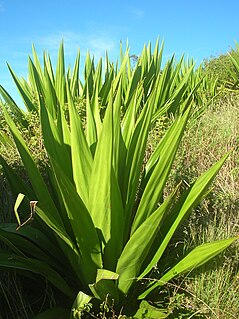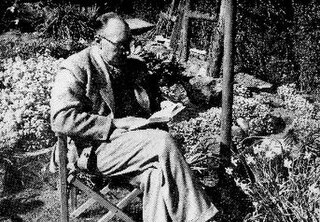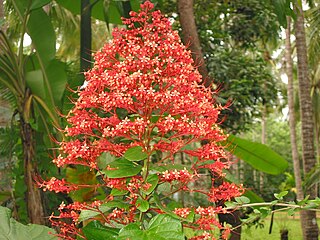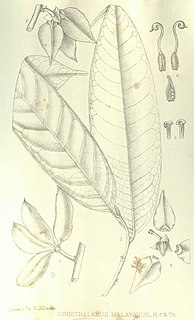
Furcraea foetida is a species of flowering plant native to the Caribbean and northern South America. It is widely cultivated and reportedly naturalized in many places

The Acharya Jagadish Chandra Bose Indian Botanic Garden previously known as Indian Botanic Garden and the Calcutta Botanic Garden, is situated in Shibpur, Howrah near Kolkata. They are commonly known as the Calcutta Botanical Garden and previously as the Royal Botanic Garden, Calcutta. The gardens exhibit a wide variety of rare plants and a total collection of over 12,000 specimens spread over 109 hectares. It is under Botanical Survey of India (BSI) of Ministry of Environment and Forests, Government of India.

Colonel Robert Kyd was a British army officer stationed in India. He founded the botanical garden at Calcutta in 1787.

Campylospermum serratum is a plant in the family Ochnaceae. The specific epithet serratum is from the Latin meaning "with teeth", referring to the leaf margin. It is found in Tropical Asia, from Sulawesi, Indonesia to Hainan, Zhōngguó/China and over to southwester India. Gomphia serrata was a previous common name for the species. The plant is used for it wood and its sap is used in folk medicine and in the past for teeth-blackening.

Bambusa tulda, or Indian timber bamboo, is considered to be one of the most useful of bamboo species. It is native to the Indian subcontinent, Indochina, Tibet, and Yunnan, and naturalized in Iraq, Puerto Rico, and parts of South America.

Isaac Henry Burkill was an English botanist who worked in India and in the Straits Settlements. He worked primarily in economic botany but published extensively on plant biology, ethno-botany, insect-plant interactions and described several species. He published a two volume compilation on the plants of economic importance in the Malay Peninsula, collating local names and knowledge. He also wrote a detailed history of botany in India. The plant genera Burkillia and Burkillianthus were named in his honour.
Pseudanthistiria is a genus of Asian plants in the grass family.

Pseudoraphis is a genus of Asian and Australian plants in the grass family, commonly known as mudgrasses.
Acroceras is a genus of tropical and subtropical plants in the grass family.

Spathoglottis plicata, commonly known as the Philippine ground orchid, or large purple orchid is an evergreen, terrestrial plant with crowded pseudobulbs, three or four large, pleated leaves and up to forty resupinate, pink to purple flowers. It is found from tropical and subtropical Asia to Australia and the western Pacific including Tonga and Samoa.
Halopyrum is a genus of Asian and African plants in the grass family. The only known species is Halopyrum mucronatum, native to the Indian Subcontinent, Iran, the Arabian Peninsula, Socotra, Madagascar, and eastern + northeastern Africa.
Lasiurus is a genus of Asian and African plants in the grass family, Poaceae, found primarily in arid regions. The only known species is Lasiurus scindicus, native to drier regions of northern Africa and southwestern Asia, from Morocco and Mali to India.
Leptaspis is a genus of Paleotropical plants in the grass family, native to Africa, southern Asia, northern Australia, and a few islands of the western Pacific.
Ochthochloa is a genus of desert plants in the grass family native to the Sahara and Arabian Deserts. The only known species is Ochthochloa compressa, whose native range extends from Algeria to Uttarakhand.

Murray Ross Henderson (1899–1982) was a Scottish botanist who did most of his botanical work in the Straits Settlements and South Africa. He took a position as a botanist in Malaya in 1921 and became curator of the herbarium in the Singapore Botanical Gardens in 1924.

Typhonium flagelliforme is a species of flowering plant in the family Araceae.

Elaeocarpus lanceifolius is a tree species in the family Elaeocarpaceae. It is found across tropical Asia from Thailand to Yunnan to Nepal to Karnataka, India. It is used for its wood, fruit, and nuts.

Amischotolype is a genus of perennial monocotyledonous flowering plants in the dayflower family. It is found in Central Africa and from India through Southeast Asia to New Guinea, with the great majority or species found in Asia.

Clerodendrum paniculatum, the pagoda flower, is a species of flowering plant in the genus Clerodendrum and family Lamiaceae. It is native to tropical Asia and Papuasia. It is reportedly naturalized in India, Fiji, French Polynesia, and Central America.

Goniothalamus malayanus is a species of plant in the family Annonaceae. It is native to Borneo, the Malay Peninsula, the Nicobar Islands, Sumatra and Thailand. Joseph Dalton Hooker and Thomas Thomson, the British botanists who first formally described the species, named it after part of its habitat range, British Malaya.













